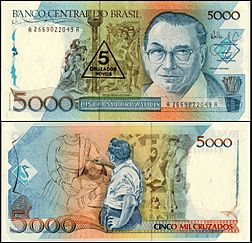Cruzado
| Brazilian cruzado | |
|---|---|
| cruzado brasileiro (Portuguese) | |

A 5000 cruzado banknote featuring Candido Portinari, overstamped as a 5 cruzados novos banknote
|
|
| ISO 4217 | |
| Code | BRC |
| Denominations | |
| Subunit | |
| 1/100 | centavo |
| Plural | cruzados |
| Symbol | Cz$ |
| Banknotes | |
| Freq. used | 10, 50, 100, 500, 1000, 5000, 10,000 cruzados |
| Coins | |
| Freq. used | 1, 5, 10 cruzados |
| Rarely used | 1, 5, 10, 20, 50 centavos |
| Demographics | |
| User(s) |
|
| Issuance | |
| Central bank | Central Bank of Brazil |
| Website | www |
| Printer | Casa da Moeda do Brasil |
| Website | www |
| Mint | Casa da Moeda do Brasil |
| Website | www |
The cruzado was the currency of Brazil from 1986 to 1989. It replaced the second cruzeiro (at first called the "cruzeiro novo") in 1986, at a rate of 1 cruzado = 1000 cruzeiros (novos) and was replaced in 1989 by the cruzado novo at a rate of 1000 cruzados = 1 cruzado novo.
This currency was subdivided in 100 centavos and it had the symbol and the ISO 4217 code BRC.
Stainless-steel coins were introduced in 1986 in denominations of 1, 5, 10, 20 and 50 centavos, and 1 and 5 cruzados, with 10 cruzados following in 1987. Coin production ceased in 1988.
100 cruzado coins commemorating the centenary of the abolition of slavery (the Lei Áurea) were produced in 1988. Although rare in circulation, the designs were carried over into the series issued between 1989 and 1991.
The first banknotes were overprints on cruzeiro notes, in denominations of 10, 50 and 100 cruzados. Regular notes followed in denominations of 10, 50, 100 and 500 cruzados, followed by 1000 cruzados in 1987, 5000 and 10,000 cruzados in 1988.
...
Wikipedia

